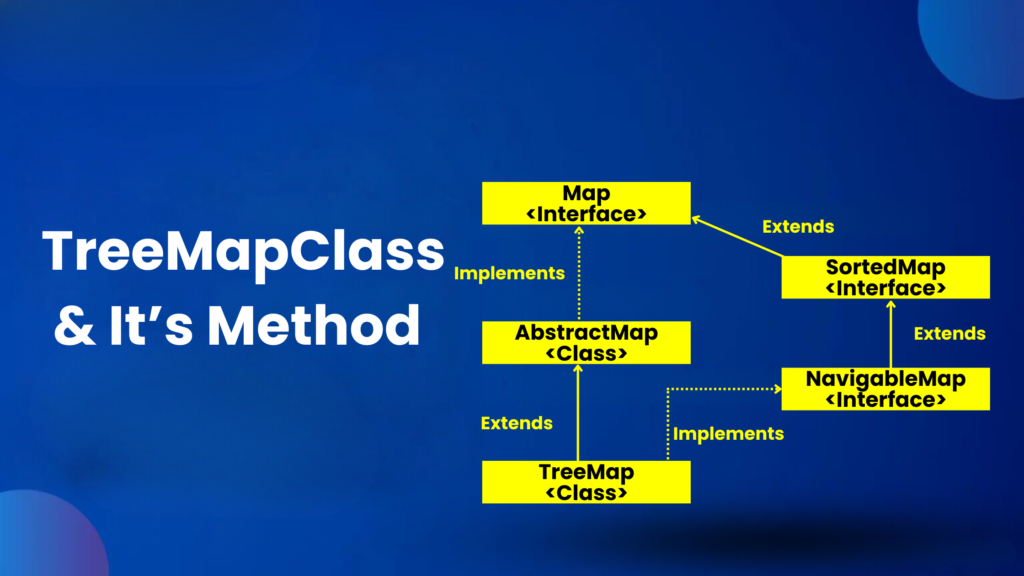

TreeMapClass and its methods
Before going into TreeMapClass let us discuss about Map Hierarchy
Map Hierarchy
The below diagram shows the Map hierarchy consisting of classes and interfaces.

Now let us discuss about TreeMapClass and its methods
What is TreeMapClass?
TreeMapClass is the implemented class of Map interface,SortedMap interface and NavigationMap interface. It stores pairs of keys and values. Using TreeMap class we can remove a specific key value pair,display a particular key value pair and add new key value pairs. TreeMap class is found in java.utils package. It cannot have null key but can have multiple null values. TreeMap class is neither thread safe nor synchronized.It’s growth strategy is it grows dynamically.. It has no threshold.
Methods of TreeMapClass
Below are some of the methods of TreeMapClass:
| Method Name | Description |
| put(Object key, Object value) | It is used to add a pair of key and value into the TreeMap. |
| putAll(Map m) | It is used to add all pairs of keys and values from one TreeMap to another TreeMap. |
| clear() | It is used to clear all key and value pairs present in TreeMap. |
| size() | It is used to display the size of the key and value pairs present in TreeMapClass. |
| containsKey(Object key) | It is used to check if the specified key is present among all the key and value pairs of TreeMap class. It gives ‘true’ value if the specified Key is present among all the key and value pairs and ‘false’ value if the specified key is not present among all the key and value pairs. |
| containsValue(Object value) | It is used to check if the specified value of a key is present among all the key and value pairs of TreeMap class. It gives ‘true’ value if the specified value of a key is present among all the key and value pairs and ‘false’ value if the specified value of a key is not present among all the key and value pairs. |
| equals(Object o) | It is used to check if key and value pairs present in one TreeMapClass is equal to the key and value pairs present in another TreeMapClass. It gives ‘true’ value if key and value pairs present in two TreeMapClasss are equal and ‘false’ value if key and value pairs present in two TreeMapClasss are not equal. |
| get(Object key) | It is used to display the value of a specified key among all key and value pairs of HashSet. It displays ‘null’ if the specified key is not present among all key and value pairs of TreeMapClass. |
| isEmpty() | It is used to check if the TreeMapClass class is empty or not. It display ‘true’ value if the TreeMapClass class is empty and ‘false’ value if the TreeMapClass class is not empty. |
| keySet() | It is used to display the keys among all the key and value pairs present in TreeMap. |
| remove(Object key) | It is used to remove a specified key and value pair from the TreeMapClass. If we try to print a key which is not present in TreeMapClass it will display null value but if we try to print a key which is present in TreeMapClass it will display its corresponding value. |
| values() | It is used to display the corresponding values of the keys present in the TreeMap |
| putIfAbsent(Object key, Object value) | Using this method, the specified key and value pairs get added alongwith the key and value pairs present in TreeMap if that key and value pair is absent in the TreeMap. If the specified key and value is present in the TreeMap the specified key and value pair will not get added again in the TreeMap. This method will also display the value of the specified key and value pair if that key and value pair is present in TreeMap. If the specified key and value pair is not displayed in TreeMap then null will be displayed. |
| replace(Object key, Object oldValue, Object newValue) | It is used to replace the old value of the specified key with a new value. Here we also mention the old value of the specified key. |
| replace(Object key, Object value) | It is used to replace the old value of the specified key with a new value. |
| entrySet() | It is used to display all the key and value pairs present in TreeMap. |
| clone() | It is used to create a shallow copy of the key and value pairs present in TreeMap. |
| firstKey() | It is used to display the first key from the list of key and value pairs displayed in output console of TreeMap. |
| lastKey() | It is used to display the last key from the list of key and value pairs displayed in output console of TreeMap. |
1. Let us check how put(Object key, Object value) method works in TreeMap class.
Code Snippet:
package treeSet;
import java.util.TreeSet;
public class TreeSetClass {
public static void main(String[] args) {
TreeSet a1= new TreeSet();
a1.add("hello");
a1.add("Heya");
a1.add("Hey");
a1.add("Hji");
a1.add("Hiii");
System.out.println(a1);
}
}
Output: [Hey, Heya, Hiii, Hji, hello]
Screenshot:

2. Let us check the usage of addAll(Collection c) method in TreeSet class.
Code Snippet:
package treeSet;
import java.util.TreeSet;
public class TreeSetClass {
public static void main(String[] args) {
TreeSet a1= new TreeSet();
a1.add("hello");
a1.add("Heya");
a1.add("Hey");
a1.add("Hji");
a1.add("Hiii");
TreeSet a2= new TreeSet();
a2.addAll(a1);
System.out.println(a2);
}
}
Output: [Hey, Heya, Hiii, Hji, hello]
Screenshot:

3. Let us check the usage of clear() method inTreeSet class.
Code Snippet:
package treeSet;
import java.util.TreeSet;
public class TreeSetClass {
public static void main(String[] args) {
TreeSet a1= new TreeSet();
a1.add("hello");
a1.add("Heya");
a1.add("Hey");
a1.add("Hji");
a1.add("Hiii");
a1.clear();
System.out.println(a1);
}
}
Output: []
Screenshot:

4. Let us check the usage of contains(Object o) method in TreeSet class.
Code Snippet:
package hashSetClass;
import java.util.HashSet;
public class HashSetClass {
public static void main(String[] args) {
HashSet a1= new HashSet();
a1.add("hello");
a1.add('c');
a1.add(3.4f);
a1.add(true);
a1.add(null);
a1.add(3.55);
a1.add("Hiii");
System.out.println("The given TreeSet contains: "+a1.contains("hello"));
System.out.println("The given TreeSet contains: "+a1.contains("Harish"));
}
}
Output: The given TreeSet contains: true
The given TreeSet contains: false
Screenshot:

5. Let us check the usage of containsAll(Collection c) method in TreeSet class.
Code Snippet:
package treeSet;
import java.util.TreeSet;
public class TreeSetClass {
public static void main(String[] args) {
TreeSet a1= new TreeSet();
a1.add("hello");
a1.add("Heya");
a1.add("Hey");
a1.add("Hji");
a1.add("Hiii");
TreeSet a2= new TreeSet();
a2.add("hello");
a2.add("Heya");
a2.add("Hey");
System.out.println("Does a2 contains all elements of a1:"+a2.containsAll(a1));
System.out.println("Does a1 contains all elements of a2:"+a1.containsAll(a2));
}
}
Output:
Does a2 contains all elements of a1:false
Does a1 contains all elements of a2:true
Screenshot:

6. Let us check the usage of isEmpty() method in TreeSet class.
Code Snippet:
package treeSet;
import java.util.TreeSet;
public class TreeSetClass {
public static void main(String[] args) {
TreeSet a1= new TreeSet();
a1.add("hello");
a1.add("Heya");
a1.add("Hey");
a1.add("Hji");
a1.add("Hiii");
System.out.println("Is a1 TreeSet empty?: "+a1.isEmpty());
TreeSet a2= new TreeSet();
System.out.println("Is a2 TreeSet empty?: "+a2.isEmpty());
}
}
Output:
Is a1 TreeSet empty?: false
Is a2 TreeSet empty?: true
Screenshot:

7. Let us check the usage of iterator() method in TreeSet class.
Code Snippet:
import java.util.Iterator;
import java.util.TreeSet;
public class TreeSetClass {
public static void main(String[] args) {
TreeSet a1= new TreeSet();
a1.add("hello");
a1.add("Heya");
a1.add("Hey");
a1.add("Hji");
a1.add("Hiii");
Iterator a2= a1.iterator();
System.out.println("The collection elements values are: ");
while(a2.hasNext())
{
System.out.println(a2.next());
}
}
}
Output:
The collection elements values are:
Hey
Heya
Hiii
Hji
hello
Screenshot:

8. Let us check the usage of remove(Object o) method in TreeSet class.
Code Snippet:
package treeSet;
import java.util.TreeSet;
public class TreeSetClass {
public static void main(String[] args) {
TreeSet a1= new TreeSet();
a1.add("hello");
a1.add("Heya");
a1.add("Hey");
a1.add("Hji");
a1.add("Hiii");
a1.remove("hello");
System.out.println(a1);
}
}
Output: [Hey, Heya, Hiii, Hji]
Screenshot:

9. Let us check the usage of removeAll(Collection c) method in TreeSet class.
Code Snippet:
package treeSet;
import java.util.TreeSet;
public class TreeSetClass {
public static void main(String[] args) {
TreeSet a1= new TreeSet();
a1.add("hello");
a1.add("Heya");
a1.add("Hey");
a1.add("Hji");
a1.add("Hiii");
a1.add("Heiz");
TreeSet a2= new TreeSet();
a2.add("hello");
a2.add("Heya");
a2.add("Hey");
a2.add("Hiii");
a1.removeAll(a2);
System.out.println("Elements present in a1 after removing a2 elements from a1 are:"+a1);
}
}
Output:
Elements present in a1 after removing a2 elements from a1 are:[Heiz, Hji]
Screenshot:

10. Let us check the usage of retainAll(Collection c) method in TreeSet class.
Code Snippet:
package treeSet;
import java.util.TreeSet;
public class TreeSetClass {
public static void main(String[] args) {
TreeSet a1= new TreeSet();
a1.add("hello");
a1.add("Heya");
a1.add("Hey");
a1.add("Hji");
a1.add("Hiii");
a1.add("Heiz");
TreeSet a2= new TreeSet();
a2.add("hello");
a2.add("Heya");
a2.add("Hey");
a2.add("Hiii");
a1.retainAll(a2);
System.out.println("Elements present in a1 after retaining a2 elements from a1 are:"+a1);
}
}
Output: Elements present in a1 after retaining a2 elements from a1 are:[Hey, Heya, Hiii, hello]
Screenshot:

11. Let us check the usage of size() method in TreeSet class.
Code Snippet:
package treeSet;
import java.util.TreeSet;
public class TreeSetClass {
public static void main(String[] args) {
TreeSet a1= new TreeSet();
a1.add("hello");
a1.add("Heya");
a1.add("Hey");
a1.add("Hji");
a1.add("Hiii");
a1.add("Heiz");
System.out.println("The size of the collection elements present in the TreeSet is: "+a1.size());
}
}
Output: The size of the collection elements present in the TreeSet is: 6
Screenshot:

12. Let us check the usage of toArray() method in TreeSet class.
Code Snippet:
package treeSet;
import java.util.TreeSet;
public class TreeSetClass {
public static void main(String[] args) {
TreeSet a1= new TreeSet();
a1.add("hello");
a1.add("Heya");
a1.add("Hey");
a1.add("Hji");
a1.add("Hiii");
a1.add("Heiz");
Object a2[]= a1.toArray();
System.out.println("The list of array elements are:");
for(int i=0;i<=a2.length-1;i++)
{
System.out.println(a2[i]);
}
}
}
Output: The list of array elements are:
Heiz
Hey
Heya
Hiii
Hji
hello
Screenshot:

13. Let us check the usage of toString() method in TreeSet class.
Code Snippet:
package treeSet;
import java.util.TreeSet;
public class TreeSetClass {
public static void main(String[] args) {
TreeSet a1= new TreeSet();
a1.add("hello");
a1.add("Heya");
a1.add("Hey");
a1.add("Hji");
a1.add("Hiii");
a1.add("Heiz");
System.out.println(a1.toString());
}
}
Output: [Heiz, Hey, Heya, Hiii, Hji, hello]
Screenshot:

14. Let us check the usage of equals() method in TreeSet class.
Code Snippet:
package treeSet;
import java.util.TreeSet;
public class TreeSetClass {
public static void main(String[] args) {
TreeSet a1= new TreeSet();
a1.add("hello");
a1.add("Heya");
a1.add("Hey");
a1.add("Hji");
a1.add("Hiii");
a1.add("Heiz");
TreeSet a2= new TreeSet();
a2.add("hello");
a2.add("Heya");
a2.add("Hey");
a2.add("Hji");
a2.add("Hiii");
a2.add("Heiz");
TreeSet a3= new TreeSet();
a3.add("hello");
a3.add("Heya");
a3.add("Hey");
a3.add("Hji");
System.out.println("Is TreeSet a1 equal to a2 ?:"+ a1.equals(a2));
System.out.println("Is TreeSet a2 equal to a3 ?:"+ a2.equals(a3));
}
}
Output: Is TreeSet a1 equal to a2 ?:true
Is TreeSet a2 equal to a3 ?:false
Screenshot:

15. Let us check the usage of clone() method in TreeSet class.
Code Snippet:
package treeSet;
import java.util.TreeSet;
public class TreeSetClass {
public static void main(String[] args) {
TreeSet a1= new TreeSet();
a1.add("hello");
a1.add("Heya");
a1.add("Hey");
a1.add("Hji");
a1.add("Hiii");
a1.add("Heiz");
System.out.println("List of elements in TreeSet class: "+a1);
TreeSet clonea1= new TreeSet();
clonea1=(TreeSet)a1.clone();
System.out.println("List of elements after using clone method:"+ clonea1);
}
}
Output: List of elements in TreeSet class: [Heiz, Hey, Heya, Hiii, Hji, hello]
List of elements after using clone method:[Heiz, Hey, Heya, Hiii, Hji, hello]
Screenshot:

16. Let us check the usage of pollFirst() method in TreeSet class.
Code Snippet:
package treeSet;
import java.util.TreeSet;
public class TreeSetClass {
public static void main(String[] args) {
TreeSet a1= new TreeSet();
a1.add(6);
a1.add(7);
a1.add(3);
a1.add(4);
a1.add(9);
a1.pollFirst();
System.out.println(a1);
}
}
Output: [4, 6, 7, 9]
Screenshot:

17. Let us check the usage of pollLast() method in TreeSet class.
Code Snippet:
package treeSet;
import java.util.TreeSet;
public class TreeSetClass {
public static void main(String[] args) {
TreeSet a1= new TreeSet();
a1.add(6);
a1.add(7);
a1.add(3);
a1.add(4);
a1.add(9);
a1.pollLast();
System.out.println(a1);
}
}
Output: [3, 4, 6, 7]
Screenshot:

18. Let us check the usage of first() method in TreeSet class.
Code Snippet:
package treeSet;
import java.util.TreeSet;
public class TreeSetClass {
public static void main(String[] args) {
TreeSet a1= new TreeSet();
a1.add(6);
a1.add(7);
a1.add(3);
a1.add(4);
a1.add(9);
System.out.println(a1.first());
}
}
Output: 3
Screenshot:

19. Let us check the usage of last() method in TreeSet class.
Code Snippet:
package treeSet;
import java.util.TreeSet;
public class TreeSetClass {
public static void main(String[] args) {
TreeSet a1= new TreeSet();
a1.add(6);
a1.add(7);
a1.add(3);
a1.add(4);
a1.add(9);
System.out.println(a1.last());
}
}
Output: 9
Screenshot:

- Let us check the usage of descendingIterator() method in TreeSet class.
Code Snippet:
package treeSet;
import java.util.Iterator;
import java.util.TreeSet;
public class TreeSetClass {
public static void main(String[] args) {
TreeSet a1= new TreeSet();
a1.add(6);
a1.add(7);
a1.add(3);
a1.add(4);
a1.add(9);
Iterator a2= a1.descendingIterator();
System.out.println("The collection elements values in descending order are: ");
while(a2.hasNext())
{
System.out.println(a2.next());
}
}
}
Output: The collection elements values in descending order are:
9
7
6
4
3
Screenshot:

21. Let us check the usage of descendingSet() method in TreeSet class.
Code Snippet:
package treeSet;
import java.util.TreeSet;
public class TreeSetClass {
public static void main(String[] args) {
TreeSet a1= new TreeSet();
a1.add("A");
a1.add("B");
a1.add("C");
a1.add("D");
a1.add("E");
System.out.println("Reverse Set: "+a1.descendingSet());
}
}
Output: Reverse Set: [E, D, C, B, A]
Screenshot:

22. Let us check the usage of ceiling(Object e) method in TreeSet class.
Code Snippet:
package treeSet;
import java.util.TreeSet;
public class TreeSetClass {
public static void main(String[] args) {
TreeSet a1= new TreeSet();
a1.add(10);
a1.add(20);
a1.add(30);
a1.add(40);
a1.add(50);
System.out.println("The given TreeSet elements :"+a1);
System.out.println("The ceiling value of 22 is :"+a1.ceiling(22));
}
}
Output: The given TreeSet elements :[10, 20, 30, 40, 50]
The ceiling value of 22 is :30
Screenshot:

23. Let us check the usage of floor(Object e) method in TreeSet class.
Code Snippet:
package treeSet;
import java.util.TreeSet;
public class TreeSetClass {
public static void main(String[] args) {
TreeSet a1= new TreeSet();
a1.add(10);
a1.add(20);
a1.add(30);
a1.add(40);
a1.add(50);
System.out.println("The given TreeSet elements :"+a1);
System.out.println("The floor value of 42 is :"+a1.floor(40));
}
}
Output: The given TreeSet elements :[10, 20, 30, 40, 50]
The floor value of 42 is :40
Screenshot:

Difference between LinkedHashSet and TreeSet
| SL NO: | LinkedHashSet | TreeSet |
| 1 | It is the subclass of HashSet and the implemented class of Set interface,Collection interface and Iterable interface | It is the implemented class of NavigationSet interface,SortedSet interface,Set interface,Collection interface and Iterable interface |
| 2 | It allows one null value | It does not allow any null value |
| 3 | Sorting happens after converting LinkedHashSet into ArrayList | By default sorting happens in ascending order |
| 4 | The growth strategy is that it increases its capacity when it reaches the load factor (default 0.75) | The growth strategy is that it grows dynamically |
| 5 | It’s threshold is 0.75 times its current capacity | It has no threshold |
Conclusion
TreeSet class is used for handling all the Collection elements in an effective way. It is necessary to understand the usage of all the methods of TreeSet for better handling of Collection elements. Remember to practice, stay updated with the latest trends in Automation Software Testing Course,and maintain a positive attitude throughout your interview process. By thoroughly understanding the TreeSet class and its methods developers and testers can utitlise those concepts in their real life tasks.
Also read:
Consult Us


















